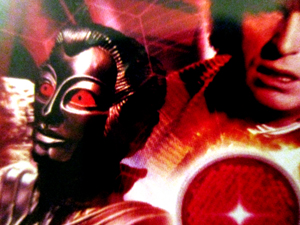The Robots of Death
“It’s rather like being surrounded by walking, talking, dead men.” – The Doctor
I don’t have the rose-colored glasses of a childhood viewing memory of this story and thus have had a harder time as an adult looking past the odd clothing design for the characters. In fact, I’ve consistently downgraded the story because I find the extremely flamboyant art-deco styling entirely off-putting and could not understand why this was consistently graded as a top story. Only on this re-watch was I able to appreciate the writing of the story, the subtly witty dialogue, and the ironic situations that do make this a very well done script.
The story plays out like a whodunit with characters we suspect of being the villain either dying or being red herrings. This in itself keeps the story somewhat engaging, especially as the characters start throwing out a lot of hints and allegations. There’s a lot of workplace tension that rings true as well. The fast-flying dialogue full acerbic comments is really a stand out part of the story. There’s some world building as we’re introduced to a rather indolent civilization where most of the hard work is done by robots and the idea that it can lead to a crisis of confidence in humanit. (“You know, people never really lose that feeling of unease with robots. The more of them there are, the greater the unease and of course the greater the dependence. It’s a vicious circle. People can neither live with them nor exist without them.”)
The Doctor and Leela also get a lot of nice interaction. The opening scenes on the TARDIS are nice (Leela thinking the yoyo the Doctor gave her is somehow operating the TARDIS and the Doctor’s explanation of transdimensional engineering), and throughout the story we really see their relationship grow with the Doctor giving her more and more responsibility and her surprising him with her ability in some areas. One of my favorite examples of this is how Leela knows on pure instinct to be wary of Poul because of his tendency to “move like a hunter.” The Doctor only later explains the same idea with the more scientific terminology of body language but acknowledges Leela’s prior understanding. We also get to see clear evidence that Leela is no wilting flower—when captured and slapped by Uvanov, she immediately takes him down with an unexpected kick and bares her teeth as she growls “You try that again and I’ll cripple you.” She even shows quite an ability at medical care, again without formal training but rather just the experience of her people: “My tribe has a saying. If you’re bleeding, look for a man with scars.” I hadn’t really realized how much this story establishes her as a strong character.
As for the crew, there are given some odd and distinct personalities some of which are a little too exaggerated. Part of it is to make you suspicious of certain people. The captain is entirely unlikeable for this reason for example but I don’t like when they try to redeem him at the end and show him as misunderstood and really a good guy at heart—there’s just too much evidence to the contrary before that to make it work. Poul’s breakdown is a bit out of left field but again intended as a red herring. For some reason, Toos comes across as a very sympathetic character and you feel very bad for her that after being so scared of being killed by the robots it looks like she will be. I was glad she survived to the end. The character we’re supposed to like most is D84, the clumsy detective robot with a heart of gold. The delivery of his lines is just a little too emotionless for me to really warm up to him in the way we’re supposed to before he sacrifices himself to save the Doctor.
Best (or worst) unsettling moment:
I couldn’t remember who actually makes it through in this story so despite myself I was on the edge of my seat with worry as Tooms and Uvanov were besieged in the control room hearing their cohort Dask banging on the door begging to be let in. Since we know he is the bad guy, I was thinking “Oh no, after making it through all that their going to open the door and be killed! Don’t open it! Don’t open it!” It was a big relief when they reasoned out not too—and a shock when it flips to the sudden closeup of Dask insanely made up like his robot ‘brothers’.
Firsts:
- Whodunit episode
Regrets:
The costumes—the silly distracting and impractical costumes. I would have much preferred them to be dressed in mining overalls or futuristic coveralls as one might expect on a mining spaceship. Yes, I get that the society is meant to be so dependent on robots that even low-class workers can be effete and artsy and that has led to such grand designs even down to elaborate makeup, but it’s all just too much and I can’t enjoy it. I want to laugh when Uvanov dons his captain’s hat.
Other than that, there are a few bumps along the way like the fact that you can actually tell who the washed out face on the secret screen is which gives away the whole mystery. (Maybe on less high definition 1970s screens that wouldn’t have been so clear.)

